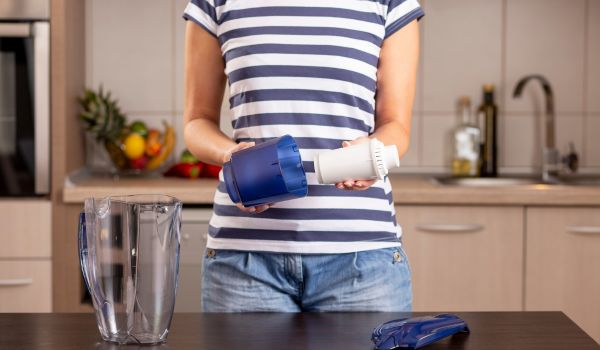If you rely on a Brita filter for cleaner, better-tasting water, you might be wondering: how long do these filters actually last before they stop working?
The short answer? It depends — on the model you use, how often you refill it, and even your local water quality.
The good news? A few simple habits can help you get the most life (and value) out of every Brita filter you buy.
Let’s break it down — how to spot when it’s time for a change, what impacts lifespan, and how to make your pitcher last longer. 🧠
🧠 Quick Takeaways
- ✅ Most Brita filters last 2–6 months, depending on type and usage.
- ✅ Signs it’s time to replace: bad taste, odd odors, slow flow, or cloudy water.
- ✅ Hard or dirty water can shorten your filter’s life faster.
- ✅ Regular cleaning helps extend both filter and pitcher performance.
- ✅ Choosing the right Brita model for your home = longer life and better water quality.
🔄 Brita Filter Types and Their Lifespan

Brita makes a few different filter types, and they don’t all last the same amount of time. Here’s a simple breakdown:
| 🔍 Filter Type | ⚡ Capacity | ⏳ Typical Lifespan |
|---|---|---|
| 🏆 Elite (Longlast+) Filter | 120 gallons | Up to 6 months |
| 💧 Standard Filter | 40 gallons | About 2 months |
| 🚰 Stream Filter | 40 gallons | About 2 months |
| 🥤 Bottle Filter | 40 gallons | About 2 months |
| 🛠️ Faucet Mount Filter | 100 gallons | About 4 months |
💬 Good to Know: These are estimates based on “average” water use. If your tap water has a lot of sediment, chlorine, or weird odors, your filter might not last quite as long.
🛑 Signs It’s Time to Replace Your Brita Filter

Your Brita filter doesn’t last forever — here’s how to spot when it’s time to swap:
- ✅ Off Taste – If your water starts tasting flat, metallic, or stale, your filter may be saturated.
- ✅ Bad Odors – A musty or chlorine smell signals it’s no longer trapping contaminants effectively.
- ✅ Slow Filtration – Water trickling slowly instead of flowing smoothly means clogging inside the filter.
- ✅ Cloudy Water – If your filtered water looks hazy or you see black carbon particles, it’s replacement time.
- ✅ Indicator Light Alert – Many Brita pitchers have a filter change light — when it blinks or turns red, it’s go time.
💬 Good to Know: Even if your indicator light hasn’t gone off, trust your senses — if the taste, smell, or clarity changes, don’t wait to replace the filter.
🛠️ Need a step-by-step guide for swapping filters?
Here’s how to clean and maintain your water filter pitcher properly for the best performance. 🧽
🧠 Looking for a backup pitcher while you clean or rotate filters?
Check out our top-rated water filter pitchers here.
Taking a few extra minutes to replace your Brita filter at the right time keeps your water tasting fresh — and protects you from drinking contaminants that could slip through an exhausted filter.
It’s a small habit that pays off with cleaner, healthier water every day. 💧
🛠️ How to Replace a Brita Filter (Step-by-Step)

Changing your Brita filter isn’t rocket science — but a few simple steps can make the swap smoother (and keep your water tasting its best):
- ✅ 1. Discard the Old Filter: Remove the used filter and dispose of it responsibly. (Brita has a recycling program if you want to be extra green.)
- ✅ 2. Flush the New Filter: Run cold water through the new filter for about 15 seconds. This clears out any carbon dust from manufacturing.
- ✅ 3. Insert and Lock In: Press the new filter firmly into the reservoir. A little wiggle helps it seal properly.
- ✅ 4. Reset the Indicator Light (If Available): Most Brita pitchers have a small button you press and hold after a filter change.
- ✅ 5. Fill and Flush: Discard the first full reservoir of filtered water. This final flush ensures your next glass is pure and fresh.
💬 Good to Know: Always handle new filters with clean hands — oils from your fingers can reduce the filter’s effectiveness over time.
🧽 How to Make Your Brita Filter Last Longer
Want to squeeze every drop of value out of your Brita filter? A little extra care goes a long way:
- ✅ Clean the Pitcher Regularly: Wash the pitcher, reservoir, and lid with mild soap and warm water at least once a week to prevent mold or mildew buildup.
- ✅ Store It Properly: Keep your Brita pitcher in the fridge (if space allows) or in a cool, shaded spot. Avoid direct sunlight, which can speed up bacterial growth.
- ✅ Avoid Overfilling: Don’t cram more water than the reservoir can handle — it can cause leaks or weaken the lid and filter connection.
- ✅ Use Cold Water Only: Brita filters are designed for cold tap water. Hot water can damage the filter and release contaminants instead of trapping them.
- ✅ Pay Attention to the Indicator Light: If your pitcher has one, don’t ignore it! Reset after each filter change, and swap filters once the light tells you it’s time.
💬 Good to Know: Keeping your pitcher clean not only extends the life of the filter — it also keeps your water tasting as fresh as possible!
💧 How Water Quality Impacts Your Brita Filter Lifespan

Not all water is created equal — and if your tap water is heavy on contaminants, your Brita filter might work overtime (and wear out faster).
Here’s how different factors affect filter life:
- ✅ Hard Water: High calcium and magnesium levels can clog the filter media faster, especially if you see white residue on faucets or dishes.
- ✅ High Chlorine Content: Municipal water treated with a lot of chlorine saturates carbon filters more quickly, reducing effectiveness sooner.
- ✅ Sediment or Turbidity: Cloudy, gritty water makes filters work harder to trap particles, speeding up the need for replacement.
- ✅ Chemical Pollutants: Pesticides, industrial runoff, and other chemicals can overwhelm filters if concentrations are high — even though Brita helps reduce many of these.
- ✅ Organic Matter: Wells and surface water supplies sometimes carry extra organic debris that clogs filters faster than treated city water.
📋 Pro Tip: Want to know exactly what’s stressing your filter? Start by testing your tap water! A quick, affordable water test can give you a full breakdown of what’s coming through your pipes. (Here’s how to test your water easily.)
🛠️ Choosing the Right Brita Filter for Your Needs

Not all Brita filters are the same — picking the right one makes a big difference for water quality and how often you’ll need to swap it out.
Here’s a simple breakdown:
| 🧹 Filter Type | 🏠 Best For | ⚡ Highlights |
|---|---|---|
| Standard Filter | Everyday tap water (low contamination) | Reduces chlorine taste/odor, easy to find, budget-friendly |
| Elite (Longlast+) Filter | Heavily treated city water | Lasts up to 6 months, tackles lead, asbestos, benzene |
| Stream Filter | Fast-fill pitchers | Filters water as you pour, no pre-soak needed |
| Bottle Filters | On-the-go hydration | Built into Brita water bottles, good for travel and gym use |
| Faucet Mount Filters | Instant filtered tap water | Installs directly on faucet, filters out lead, chlorine, particulates |
💬 Good to Know: If your tap water contains higher levels of lead, heavy metals, or chemical byproducts (like PFAS), stepping up to an Elite Filter or even a faucet mount system might give you better protection (and longer-lasting results between changes).
🧼 Final Thoughts
Keeping your Brita filter fresh isn’t just about better tasting water — it’s about protecting your health, your wallet, and your peace of mind.
- ✅ Pay attention to subtle changes like taste, odor, and flow rate.
- ✅ Stay ahead of schedule with easy filter swaps and regular pitcher cleanings.
- ✅ Choose the right Brita filter model based on your home’s water quality.
At the end of the day, clean water shouldn’t be complicated — and with a little simple maintenance, your Brita can keep you sipping safely for months to come. 💧✨
 133 people found this helpful. Was this guide helpful to you?
133 people found this helpful. Was this guide helpful to you? 


